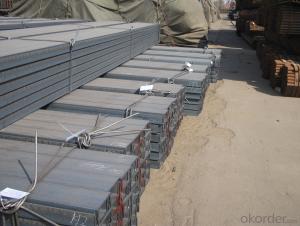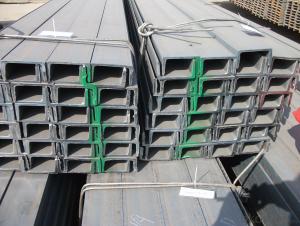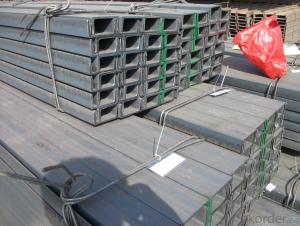JIS GB Standard Hot Rolled Steel U-channel
- Loading Port:
- China Main Port
- Payment Terms:
- TT or LC
- Min Order Qty:
- -
- Supply Capability:
- -
OKorder Service Pledge
OKorder Financial Service
You Might Also Like
Product Description:
OKorder is offering STEEL CHANNEL at great prices with worldwide shipping. Our supplier is a world-class manufacturer of steel, with our products utilized the world over. OKorder annually supplies products to European, North American and Asian markets. We provide quotations within 24 hours of receiving an inquiry and guarantee competitive prices.
Product Applications:
1.The JIS channel can be devided into two kinds, namely common channel steel and light channel steel. The sizes of hot rolled common channel steel range from 5# to 40#. Meanwhile, the channel steel can be divided into cold forming sectional equal channel steel, cold forming sectional unequal channel steel, cold forming inner edge channel steel and outer edge channel steel.
2.The JIS channel is usually used for arch-itechtural structure, and they could be welded in order to support or hang a vari-ety of facilities. They are also usually used in combination with I beam. The channel steel with sizes under 14# is usually applied to construction engineering, as purline, while the channel steel with sizes above 16# is more likely to be used in building vehicle chassis structure and mechanical structure. Furthermore, the channel steel in sizes above 30# are target at building bridge structure, as tension bar.
3.In a word, the channel steel must possess perfect welding property, riveting property and mechanical property and so on.
Product Advantages:
OKorder's STEEL CHANNELare durable, strong, and resist corrosion.
Main Product Features:
· Premium quality
· Prompt delivery & seaworthy packing (30 days after receiving deposit)
· Corrosion resistance
· Can be recycled and reused
· Mill test certification
· Professional Service
· Competitive pricing
Product Specifications:
Minimum Order Quantity: 25 Tons Unit: m.t. Loading Port: Xingang Port
Supply Ability: 1000 Tons Per Day Payment Terms: TT or L/C
Product Description:
Specifications of Steel U Channel:
Standard Applied: GB Standard, EN Standard(UPN), JIS Standard
Sizes: 50mm to 300mm
Material Grade: Q235B, Q345B, S235JR, SS400, ASTM A36
Production Flow of JIS Channel:
1.The steel billet shall be heated in the high temperature furnace.
2. The heated steel billet shall be rolled five to nine times with the aim of shaping the general figure of steel u channel.
3. The rolled steel channel should be put onto the cooling bed to make the temperature low.
4. The JIS Channel should be straighted on the straightener.
5. The straighted steel u channel will be cut into meters by saw, as per customer's requirements.
6. At the last part of production, the channel steel must be tested in order to confirm that the finished products are completely free from crack, pore, slag, scab or fold on the surface.
Package & Delivery of JIS Channel:
1.The JIS channel will be packed in bundle with steel wire at each end of every bundle and color marking in order to help the customer to recognize his goods more easily at sight.
2. And the JIS channel could be loaded into 20ft or 40ft container, or by bulk cargo.If the weight of each bundle reaches more than 3.5 mt, the loading by break bulk cargo should be choosed.When the weight of each bundle reaches less than 3mt, the loading by container should be choosed.
3.As for the transportaion from mill to loading port, the truck will be usually used. And the maximum quantity for each truck is 40mt.
4.All in all, we could do in accordance with customer's request.
JIS CHANNEL | Standard h | Sectional b | Dimension s | t | Mass: Kg/m |
| (mm) | (mm) | (mm) | (mm) |
|
50x25 | 50 | 25 | 3.0 | 6.00 | 2.37 |
75X40 | 75 | 40 | 3.8 | 7.00 | 5.30 |
75X40 | 75 | 40 | 4.0 | 7.00 | 5.60 |
75X40 | 75 | 40 | 4.5 | 7.00 | 5.85 |
75X40 | 75 | 40 | 5.0 | 7.00 | 6.92 |
|
|
|
|
|
|
100X50 | 100 | 50 | 3.8 | 6.00 | 7.30 |
100X50 | 100 | 50 | 4.2 | 6.00 | 8.03 |
100X50 | 100 | 50 | 4.5 | 7.50 | 8.97 |
100X50 | 100 | 50 | 5.0 | 7.50 | 9.36 |
|
|
|
|
|
|
125X65 | 125 | 65 | 5.2 | 6.80 | 11.66 |
125X65 | 125 | 65 | 5.3 | 6.80 | 12.17 |
125X65 | 125 | 65 | 5.5 | 8.00 | 12.91 |
125X65 | 125 | 65 | 6.0 | 8.00 | 13.40 |
|
|
|
|
|
|
150x75 | 150 | 75 | 5.5 | 7.30 | 14.66 |
150x75 | 150 | 75 | 5.7 | 10.00 | 16.71 |
150x75 | 150 | 75 | 6.0 | 10.00 | 17.90 |
150x75 | 150 | 75 | 6.5 | 10.00 | 18.60 |
150x75 | 150 | 75 | 6.5 | 10.00 | 24.00 |
|
|
|
|
|
|
200X80 | 200 | 80 | 7.5 | 11.00 | 24.60 |
Grade | Yield Strength,N/mm² | Extension Strength N/mm² | |||
Thickness of Steel,mm | |||||
≦16 | >16-≦40 | >40-≦100 | >100 | ||
SS330 | ≧205 | ≧195 | ≧175 | ≧165 | 330-430 |
SS400 | ≧245 | ≧235 | ≧215 | ≧205 | 400-510 |
SS490 | ≧285 | ≧275 | ≧255 | ≧245 | 490-610 |
SS540 | ≧400 | ≧390 | - | - | ≧540 |
Grade | Element(%) | |||
C | Mn | P | S | |
SS330 | -- | -- | ≦0.050 | ≦0.050 |
SS400 | ||||
SS490 | ||||
SS540 | ≦0.30 | ≦1.60 | ≦0.040 | ≦0.040 |
Images:
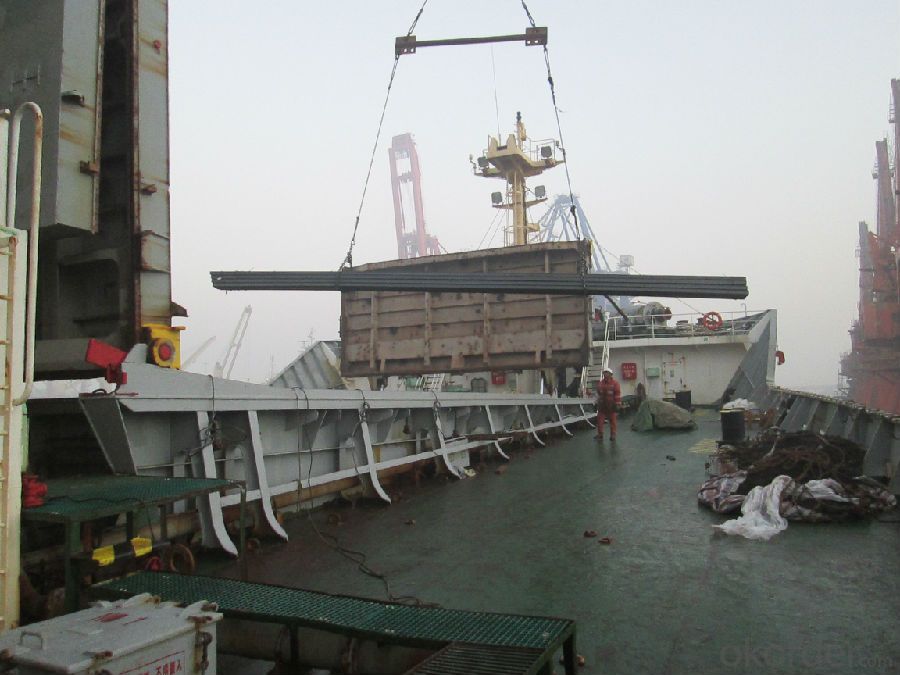
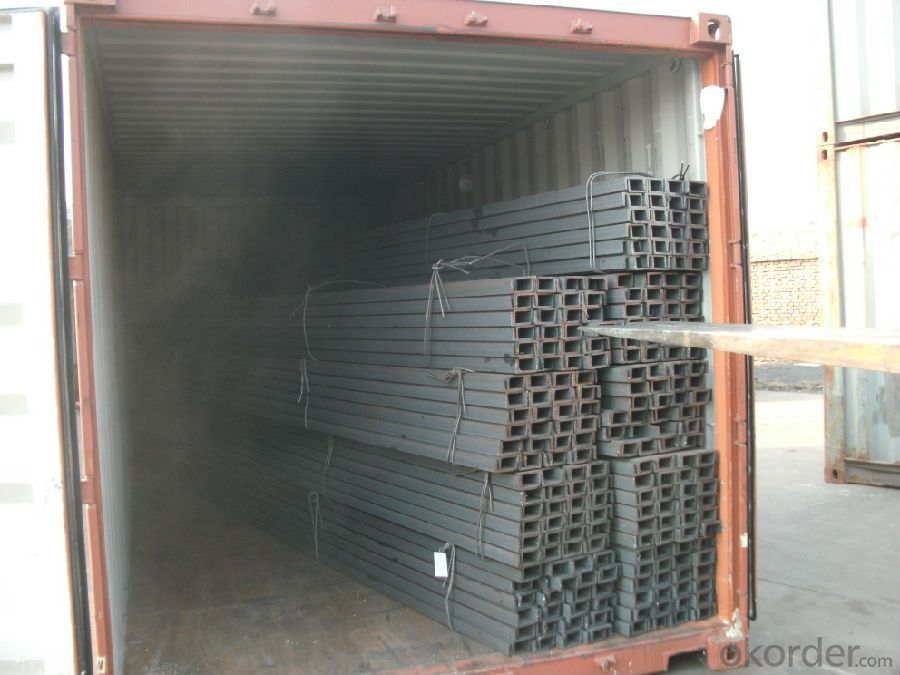
- Q:What are the different methods for transporting and handling steel channels?
- There are several different methods for transporting and handling steel channels, depending on the specific requirements and logistics of the situation. Some of the commonly used methods include: 1. Crane lifting: Steel channels can be transported and lifted using cranes equipped with hooks or lifting magnets. This method is ideal for large-scale projects or when handling heavy steel channels. 2. Forklifts: Forklifts with specialized attachments can be used to transport steel channels within a facility or construction site. This method is suitable for smaller and lighter steel channels, allowing for more precise movement and placement. 3. Conveyor systems: In manufacturing settings, conveyor systems can be implemented to transport steel channels from one process to another. This method is efficient and reduces the need for manual handling. 4. Flatbed trucks: Steel channels can be loaded onto flatbed trucks for transportation over long distances. The channels are secured using straps or chains to prevent movement during transit. 5. Palletizing: Steel channels can be stacked and secured on pallets for easier handling and transportation. This method is common when shipping smaller quantities of steel channels or for storing them in a warehouse. 6. Rollers or skids: Steel channels can be moved along rollers or skids for short distances within a facility or construction site. This method allows for easy movement and positioning of the channels. 7. Rail transportation: For larger quantities or longer distances, steel channels can be transported via rail. Specialized rail cars or containers are used to safely secure and transport the channels. It is important to consider the size, weight, and fragility of the steel channels when determining the appropriate method for transporting and handling them. Safety measures should always be followed to prevent accidents, and specific equipment may be needed depending on the chosen method.
- Q:How do steel channels contribute to the ease of construction?
- There are several ways in which steel channels contribute to the ease of construction. Firstly, they offer structural support and stability to various building components. These channels are specifically designed to withstand heavy loads and provide a solid framework for the overall structure, making them perfect for constructing beams, columns, and joists. In addition, steel channels are highly versatile and can be easily customized to meet specific construction requirements. They are available in various sizes and shapes, allowing for flexibility in design. This adaptability makes them suitable for a wide range of construction projects, whether it is for industrial buildings, bridges, or residential structures. Furthermore, steel channels are lightweight in comparison to other construction materials like concrete. This makes them much easier to handle and transport on construction sites, reducing the need for heavy machinery and manpower. The lightweight nature of steel channels also simplifies the construction process as a whole, minimizing the time and effort needed for installation. Moreover, steel channels are incredibly durable and resistant to various environmental factors, including corrosion, fire, and termites. This durability ensures that the structure remains stable and secure over time, reducing the need for frequent repairs or replacements. Additionally, it contributes to the overall sustainability of the construction industry by minimizing waste and promoting long-term use. In conclusion, steel channels play a crucial role in facilitating easy construction by offering structural support, design versatility, ease of handling, and durability. These qualities make them an essential component in modern construction, enhancing the overall efficiency and reliability of the construction process.
- Q:How do steel channels contribute to moisture control in buildings?
- Steel channels contribute to moisture control in buildings in several ways. Firstly, steel channels are often used as part of the building envelope, specifically in the construction of walls and roofs. These channels are designed to provide a barrier against moisture infiltration. When properly installed, they help to prevent rainwater, snow, and other forms of precipitation from seeping into the building, thus protecting the interior from potential water damage and mold growth. Secondly, steel channels can be used in conjunction with waterproofing systems to enhance moisture control. Waterproofing membranes or coatings are applied to the surface of the channels, creating an additional layer of protection against moisture penetration. This is particularly important in areas prone to heavy rainfall or high humidity levels. Furthermore, steel channels can be integrated into the building's drainage system. They are often used to direct rainwater away from the building and into the appropriate drainage channels or downspouts. By efficiently managing rainwater runoff, steel channels help to prevent the accumulation of water around the building, reducing the risk of moisture-related issues such as leaks and foundation damage. Lastly, steel channels can contribute to moisture control by supporting the proper ventilation of the building. Adequate airflow is crucial in regulating moisture levels within a building. Steel channels can be used as part of the ventilation system, allowing for the exchange of air and preventing the buildup of excessive humidity, which can lead to condensation and subsequent moisture issues. In summary, steel channels play a significant role in moisture control in buildings. They provide a protective barrier against moisture infiltration, can be integrated with waterproofing systems, help manage rainwater runoff, and support proper ventilation. By addressing these key aspects, steel channels contribute to maintaining a dry and healthy indoor environment while also prolonging the lifespan of the building.
- Q:Are steel channels suitable for industrial applications?
- Yes, steel channels are suitable for industrial applications due to their strength, durability, and versatility. They can be used in various industrial settings such as construction, manufacturing, and infrastructure projects, providing structural support, framework, and reinforcement. Steel channels offer excellent load-bearing capacity, resistance to corrosion, and the ability to withstand high temperatures, making them reliable and cost-effective choices for industrial applications.
- Q:Channel steel is a strip of steel with a cross section.
- Channel steel is a strip of steel with a cross section. The specifications of the method, such as 120*53*5, mean waist height of 120 mm, leg width of 53 mm channel, waist thickness of 5 mm channel, or called 12# channel. The same height of the channel, if there are several different leg width and waist thickness, also need to add a, B, C on the right side of the model to distinguish, such as 25a#, 25b#, 25c# and so on.
- Q:How do steel channels contribute to the overall durability of a structure?
- Steel channels contribute to the overall durability of a structure by providing increased strength and stability. They act as support beams, distributing the load evenly throughout the structure. This helps to prevent excessive bending or sagging, ensuring the structure remains stable and resistant to deformation. Additionally, the use of steel channels enhances the structural integrity of a building, making it more resistant to various environmental forces such as wind, earthquakes, and heavy loads.
- Q:Can steel channels be used in telecommunications towers?
- Yes, steel channels can be used in telecommunications towers. Steel channels have a range of applications due to their strength, durability, and versatility. In telecommunications towers, steel channels can be used for structural support, providing stability and load-bearing capacity for the tower. The channels can be fabricated and assembled to form the framework of the tower, allowing for the installation of various equipment such as antennas, transmitters, and receivers. Additionally, the design of steel channels allows for easy integration of cables and wiring, facilitating efficient connectivity throughout the tower. Overall, the use of steel channels in telecommunications towers ensures a sturdy and reliable infrastructure for efficient and effective communication networks.
- Q:Can steel channels be painted?
- Steel channels can indeed be painted, and this painting process can offer a protective layer that prevents corrosion and enhances their visual appeal. However, there are a few vital considerations to bear in mind when painting steel channels. Firstly, it is crucial to ensure that the surface of the channels is thoroughly clean and devoid of any dirt, grease, or rust. To achieve this, it is recommended to employ a wire brush or sandpaper to eliminate any loose particles and create a smooth surface for the paint to adhere to. Furthermore, it is of utmost importance to utilize a primer specifically formulated for metal surfaces. This will ensure appropriate adhesion and durability of the paint. Once the primer has been applied and allowed to dry, a suitable paint can be selected to coat the steel channels. It is essential to choose a paint that is compatible with metal surfaces and offers resistance to corrosion and weathering. In some cases, multiple coats of paint may be necessary to achieve the desired finish and durability. Overall, by properly preparing the surface and utilizing appropriate primers and paints, steel channels can be effectively painted to both protect and enhance their appearance.
- Q:What are the different design codes for steel channels?
- There are several design codes that are commonly used for steel channels, including the American Institute of Steel Construction (AISC) Specification for Structural Steel Buildings, Eurocode, British Standards, and Canadian Standards. These codes provide guidelines and requirements for the design and construction of steel channels to ensure structural integrity and safety.
- Q:Specification for channel steels used in fork trucks
- Specifications are as follows:25a:250x78x7x1228a:280x82x7.5x12.530a:300x85x7.5x13.5
1. Manufacturer Overview |
|
|---|---|
| Location | |
| Year Established | |
| Annual Output Value | |
| Main Markets | |
| Company Certifications | |
2. Manufacturer Certificates |
|
|---|---|
| a) Certification Name | |
| Range | |
| Reference | |
| Validity Period | |
3. Manufacturer Capability |
|
|---|---|
| a)Trade Capacity | |
| Nearest Port | |
| Export Percentage | |
| No.of Employees in Trade Department | |
| Language Spoken: | |
| b)Factory Information | |
| Factory Size: | |
| No. of Production Lines | |
| Contract Manufacturing | |
| Product Price Range | |
Send your message to us
JIS GB Standard Hot Rolled Steel U-channel
- Loading Port:
- China Main Port
- Payment Terms:
- TT or LC
- Min Order Qty:
- -
- Supply Capability:
- -
OKorder Service Pledge
OKorder Financial Service
Similar products
New products
Hot products
Related keywords
